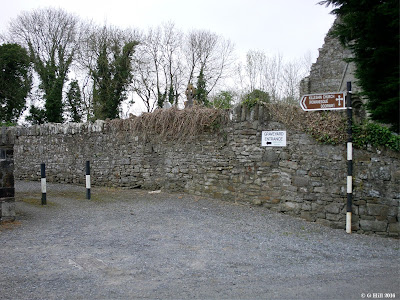Above Image: The entrance stile
Above Image: Remains of a possible additional tower?
Above Image: One of the machicolations at roof level
Above Image: Entrance door
Above Image & Below 3 Images: Views of the vaulted ceiling
Above Image: The Church ruin
Above Image: Entrance door
Above Image: The East gable
Above Image: Stones left as offerings
Above Image: West gable with some of the "stations" plaques
This sturdy tower house stands on Achill Island at the very edge of Achill Sound which is an inlet leading in from Clew Bay. It was constructed approx. around 1429 by the O’Malley’s, a great seafaring clan and subsequently became a stronghold for one of their most famous descendants the pirate queen Grace O’Malley who was born about 100 years later and ruled the seas in this area at the time.
Grace had several castles dotted around the seaboard including the commanding Rockfleet (see post here ) and another on Clare Island, her birthplace. These would have be used as havens for her pirating activities.
The three storey tower house on Achill Island stands approx. 40ft high. When we visited it was a warm summer’s day and the location just absolutely shone. The castle is close to the water and to the adjacent roadside. It is accessed by a stone stile. The doorway is open and contains a revolving metal gate so you can easily walk inside. The first floor above has a vaulted ceiling with an aperture which would have contained a stairs which is missing so there is unfortunately no access at all to above levels. The castle contains several machiolations at top level around the outside and the partial remains of a bawn at ground level one part of which appears to be the remains of a possible adjacent round tower. The castle is in a very strategic position and must have been almost impossible to make a surprise attack upon. This would have course perfectly suited Grace O’Malley’s operations.
Just a short distance from the Castle are the ruins of Kildavnet Church. The construction date is a bit unclear and there are many speculations about it. It is certain that a church was founded here in the 7th century by St Dympna thus giving the name Davnet to the site (Kil-Davnet, Church of Dympna) and that a 12th century church was also constructed here but the appearance of this ruin would suggest a later date most likely in the 1700’s when a Fr McManus was minister in the area. Indeed another view is that Grace O’Malley was supposed to have founded a church in the 16th century for the occupants of her castle to have a place of worship but this is certainly not it.
The graveyard contains some ancient stones but also two memorials. One is for the Clew Bay drowning of 1894 in which locals travelling by a small boat to Westport to meet a steamship to emigrate to Scotland drowned when the boat capsized. The other is for the Kirkintilloch fire in Glasgow of 1937 in which ten immigrant workers were killed when a fire engulfed the bothy (basically a large shed) in which they were sleeping. Their remains were returned to Achill for interment. Within the church some modern plaques have been placed which depict the Stations of the Cross and many visit the ruins to partake in the stations.
Both ruins are in a very picturesque location looking across the sound to the mainland with a backdrop of Corraun Hill.
To find the ruins tale the R319 from Mulranny (Malaranny) toward Achill Sound. Cross the bridge from the mainland to the island (It’s quite short). You will see Sweeney’s SuperValu on your right. About 1KM past the SuperValu you will see a left hand turn for the L1405. It has a sign pointing to “Atlantic Drive”. Turn left down this road and drive approx. 7KM and you will see the Church ruins on your left. The Castle is about 300m beyond. For parking drive past the Castle and park at the small pier a short distance from it which serves the Achill to Clare Island Ferry.







































